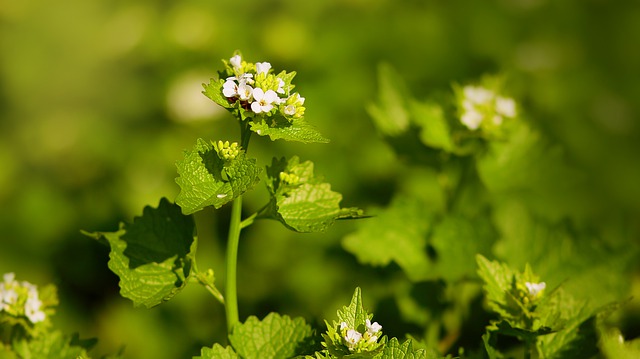 |  |  |  |  |
 |  |  |  |
Garlic Mustard is a biennial plant, from 12 cm to 1 m tall. It has a cylindrical stem with a bluish plaque. The lower part of the plant is hairy. The rhizome leaves are triangular-kidney-shaped, with a strongly toothed leaf edge and on long petioles. The upper leaves are heart-oval-shaped, with a sharply divided edge. The peculiarity of this plant is the sharp garlic smell and burning taste.
Garlic Mustard blooms in May. The flowers are small with white petals, arranged in a cluster inflorescence. Fruits - glabrous, four-sided pods. Their length varies from 2-8cm, diameter up to 2mm. The seeds are arranged in one row in the pods. Seeds elongated, striped. Seeds up to 4 mm long. The fruits ripen in June-July.
The above-ground part of the plant (leaves and seeds) is used for medicinal purposes, the stems are usually separated, as they are very juicy and difficult to dry. The leaves are collected during flowering (May), in dry weather. The seeds are collected after their ripening (in July). The leaves are collected with all the petioles or by cutting them off with scissors. The juicy leaf stalks will also prolong the drying time of the drug.
Collect the seeds by cutting the tops of the plant with all the pods! They are hung to dry, bunted and then the seeds fall off.
Both seeds and leaves are dried in well-ventilated and shaded areas. The leaves can be subjected to forced drying, not exceeding a temperature of 35C.
It is good to know that when the Garlic Mustard is dried, the characteristic garlic smell of the plant will disappear. The drug can be stored no longer than one year!
Medicinal properties of garlic are explained by its unusual chemical composition, which contains most vitamins and essential oils. The medicinal effect is directly related to the part of the plant that is used. For example, the leaves contain flavonoids, the glycoside sinigrin, ascorbic acid and carotene.
30% vegetable fat in the seeds. In turn, linoleic acid, oleic acid, erunic acid, palmitic acid and other acids are found in it. Mustard oil and thioglycoside sinigrin have also been found. It is the glycoside sinigrin that gives the plant its garlic aroma. With its help, the volatile elements of mustard oil - the source of the smell of garlic - are created.Medicinal significance
The chemical composition of Garlic Mustard provides anti-helminthic, anti-scurvy, expectorant, diaphoretic, diuretic, anti-asthmatic and antiseptic effects of the plant.
For example, the flavonoids in the Garlic Mustard leaves have a strong antioxidant effect on the human body, which promotes its recovery and gives "eternal" youth. Ascorbic acid, which is also present in the leaves of the plant, also has antioxidant properties. Carotene, in turn, improves lung function.
In the past, in folk medicine, crushed seeds of the plant were used as mustard patches are used today. Today, Garlic Mustard is used in folk medicine to prepare mouthwashes, as well as to treat burns and boils, scurvy, bronchial asthma, diarrhea, and as an anthelmintic.
In addition, water infusions from Garlic Mustard leaves are also suitable for treating wounds and cuts, skin tears, ulcers and fungi. Folk scientists believe that during avitaminosis (early spring), it is valuable to prepare soups and leaf decoctions from this plant.
In folk medicine, this plant is also used to treat gout and neuralgia.
